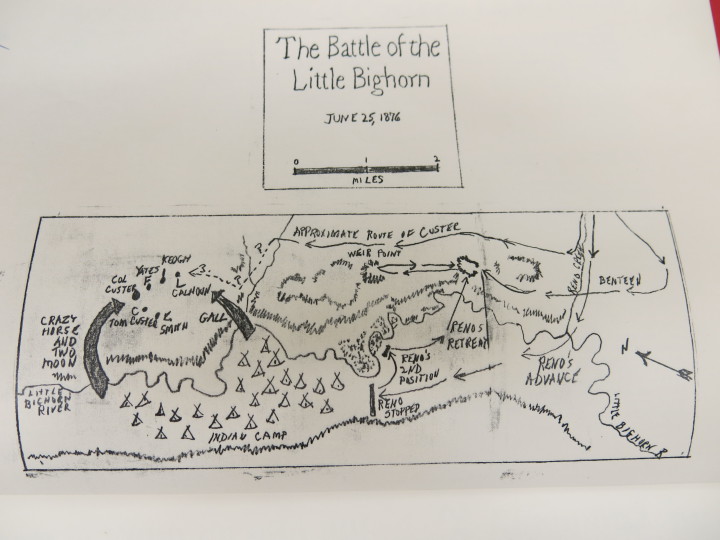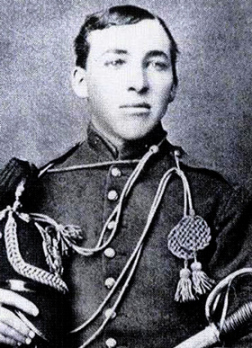Sergeant Daniel A. Kanipe, a native of McDowell County and resident of Marion, was a member of Gen. George Armstrong Custer’s doomed 7th Calvary. Additional background on the Battle of Little Bighorn, as well as more recent debates surrounding Kanipe’s role in the fight, can be found here. A state historical marker outside Kanipe’s home on Rutherford Road in Marion states Kanipe “witnessed defeat of Geo. A Custer.” However, Kanipe did not actually partake in the fight. He was the bearer of Custer’s last order, leaving before the battle began.
Kanipe died in Marion in 1926. Among the items found after his death was a memorandum of his experience in the campaign. His recollections are included in an undated document written by James E. Dean Jr., titled, “Western North Carolina Man Fought with Custer Against Sioux,” available at Pack Memorial Library’s Special Collections, North Carolina Room.
Thanks as always to the North Carolina Room for its ongoing assistance.
Daniel A. Kanipe writes:
General Custer with his five troops went in a gallop down Mud Creek toward the Little Big Horn River. About half way down this river we came to a vacated Indian tepee containing one dead Indian. At this place Major Reno came into sight on the left side of Mud Creek. He was signalled [sic] to cross the Creek to Custer where he apparently received orders to charge the Indian camps. Reno and his men went at a gallop down Mud Creek across the Little Big Horn River and down the valley toward the south end of the Indian camps.
General Custer followed the south end of the Indian camps, same route taken by Reno, a short distance, then turned squarely to the right, charging up the bluffs on the banks of the Little Big Horn where he saw a number of Indians. However, when we reached the top of the bluffs the Indians had disappeared, but we were in plain view of the Indian camps which appeared to cover a space of about two miles wide and four miles long on the west side of the river. We were then charging at full speed. Reno and his troops were again seen at our left, moving at full speed down the valley. At the sight of the Indian camps the boys of the five troops began to cheer. Some of the horses became so excited, apparently sensing something extraordinary at that moment, that their riders could not hold them in rank. The last words I heard General Custer say were: “Hold your horses in, boys, there are plenty down there for us all.” Custer and his troops were about half a mile of the east side of the Indian camps when I was ordered by General Custer, through Captain Thomas Custer, to deliver the following messages:
‘Go to Captain McDougall. Tell him to bring the pack train straight across the creek. If any packs come loose, don’t stop to fix them; cut them and come on quick. Big Indian camp. If you see Captain Benteen, tell him to come quick — big Indian camp.’

With this order I departed on my horse, Yankee Mike, which could single foot faster than most calvary horses could run. I sneaked by a number of Indians[,] and outrunning a bunch that discovered me I came to Captain Benteen and delivered the order. Benteen and his troops were watering their horses. Captain McDougall and his pack train were found about four miles from the Indian camps. The pack train went directly to the bluff where I left General Custer and his five troops.
When we reached there we found Major Reno with a remnant of three troops and Captain Benteen with three troops. Learned that Major Reno had marched to the edge of the Indian camps, dismounted and then remounted and retreated to the top of the bluffs where we found him. He had not lost a man until he began to retreat. Captain Benteen and his troops had reached the top of the bluffs just in time to prevent a massacre of all Reno’s men. When Benteen met Reno, the Indians turned again in the direction of where General Custer and his five troops of men were found dead. Being cut off from my command I remained on the bluffs with Reno’s men.
About 3 p.m. the Indians charged us again. A skirmish line formed around the pack train and horses which had been corralled. The Indians kept up a constant heavy fire until dark from all sides except the side next to the river. They made frequent charges and requiring our utmost strength to repulse them. Their charges were made hideous by their savage yells. At dark the firing ceased. On the morning of the 26th at daybreak they opened fire from all sides and during the entire day our utmost strength was required to repulse their repeated charges.
On the evening of the 26th, we could see them moving the camps in a southernly direction but the warriors kept up a constant firing until dark. On the morning of the 27th there were no Indians in sight. We had only about 182 men able for duty, 68 wounded and the remainder were dead. We then got water and made coffee. This is the first food and water we had taken since the morning of the 25th. On the 26th however, several canteens of water were obtained by several of the men which was given to the wounded, but this was little as compared to the need of the wounded. The soldiers who obtained the water obtained it under fire, two or three of them being wounded in their heroic efforts.
At about 9 a.m. we saw three columns coming up the Little Big Horn valley which upon making investigation proved to be Generals Gibbon’s and Terry’s commands. Terry reached us about 1 p.m. General Terry and staff came up to the bluffs and informed us of the massacre of General Custer and his five troops. General Terry was a kind old man and the men began to cheer him as he reached us. He broke down and cried like a child. In the fight of the battle in Little Big Horn, Montana, the 7th Cavalry lost about 265 killed and about 68 wounded.



I did not know if there were any WNC men in the 7th at the time of the Little Bighorn fight – great info! I was privileged to meet the principal archaeologist over the Custer Battlefield back in the 90’s, Dr. Richard Fox. Also got to view some artifacts and touch one of the Springfield carbines that was actually carried in the battle by a 7th Cavalry trooper, and captured by one of the Indian warriors – the provenance was its intact serial number! A lot of myths about that battle and Custer have been dispelled over the years – the fact that the historic defeat took place during the United States’ Centennial year had a lot to do with the popular versions of the incident.
Unlike the Civil War, where posters go back and forth even now for who the ‘good guys’ and ‘bad guys’ were-
The ‘good guys’ won that battle, and they weren’t Custer or his masters.
Hoka Hey.
I agree. Custer was not much of a good guy in any respect – as a leader, a Soldier or a human being. His arrogance and ineptitude cost the lives of him and his command. The Native population got a raw deal from the time our Nation was founded – first thing we did was break all the British treaties with the Indians – and went on to “amend” or completely renege on over 400 of our own treaties. And starting with the Rutherford “Punitive Expedition” against the Cherokee in 1776 and ending more or less with Wounded Knee in 1890, the US Army was used to displace and kill Indians. They got a little of their own back a couple of times, most notably the Battle of the Wabash in 1790, the “Fetterman Fight” in 1866, and the Little Bighorn, but they were worn down by the steady stream of people heading west, killing off the buffalo and other game, fencing off the land….fulfilling the “Manifest Destiny”.
The men of the Michigan Brigade loved General Custer, they followed him into battle after battle during the civil war. When the war ended and Custer said goodbye to the men the brigade gave him 3 cheers & after the war when they marched in parades they proudly wore the red scarves that set them apart as Custer’s brigade. That proves your statement is wrong in so many ways. The only thing you have right is the army was used to subdue the indians. Custer and the 7th was sacrificed in order to break the 1868 treaty & take the Black Hills from them
How do you turn this article into Custer bashing? It’s not even good bashing. Custer did what all soldiers did, he followed orders & like the 600 000 soldiers that died in the Civil war he paid the ultimate price for being a doldi